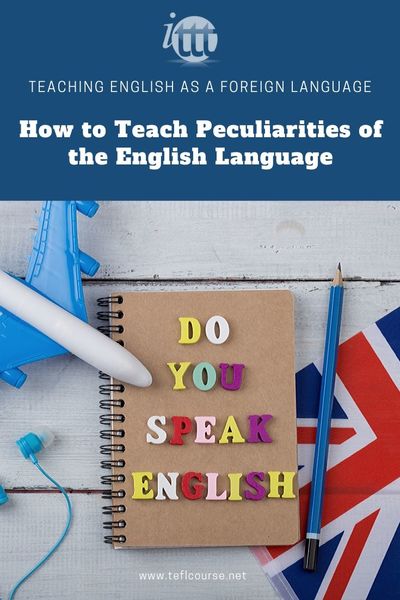How to Teach Peculiarities of the English Language

Peculiarities in the English language can be quite difficult and challenging to explain to students but are certainly very rewarding.
Table of Contents
Do you want to teach English abroad? Take a TEFL course!
This post was written by our TEFL certification graduate Monique E. Please note that this blog post might not necessarily represent the beliefs or opinions of ITTT.
General Ideas
If we look at the word "Peace" – in English this word could refer to "peace between family, neighbors, and friends" or it could mean "peace of mind" or "peace" etc. We also have the same word spoken in the same way, but spelled differently and has a completely different meaning – as in "Piece" – a piece of cake. In some languages, there is no way to use one word to convey all those different aspects of the word "Peace and Piece", because, in the students native tongue, they may only have one word for "peace" if there is war in a country, or "peace" between people when they are getting along together, or to give a certain person a "piece" of their mind, or to have a "piece" of cake. So, the students need to understand the point of each user in the context in which it is used and convey the right word and sentenced accordingly.
It doesn't mean that there will be seven words in the native language if there are seven words in the English language, as every word in the English language may not be translated, but then again – the complete thought of the English meaning has to be there. English makes effective use of repetition - what do we mean by that? – Well, you can write one sentence in English then repeat the same thought in slightly different words with the next sentence, but it is still correct and sounds fine. In some other languages, to repeat a thought could be thought of as poor writing and wouldn't reflect well on the teaching methods.

Also Read: Which are the best Spanish speaking countries for teaching English abroad?
So, in such cases, the students can combine the "two sentences" into just "one sentence", as long as the required thought is conveyed, or the students might like to make "two sentences" out of one long English sentence if that feels more natural to them. So, in summary, the student should not compare the length of a paragraph in their native language to a length of a paragraph in English. Sometimes we might hear our students say "I don't understand why the paragraph is not translated word for word" – after all, that word may be available in both languages, but could very well mean something completely different. However, for argument's sake, no matter how well a student has learned the English language, native speakers who speak the language well are usually the best judges of what is natural. Modesty, in this case, will help students to recognize that.
To convey ideas naturally, accurately and clearly, this isn't an easy thing to do. Let's discuss some of the challenges. We will focus on two areas and will see how this will help the student to make the correct choice of words in sentence structures.
Also Read: What is the English Opens Doors Program for teaching English in Chile?
1) Illustrations
Why is it that sometimes illustrations can be particularly difficult for students? An illustration thatworks in one culture might not work in another. Illustrations are only effective if the student canrelate to them and that's why it's easy to use illustrations based on everyday things that the student is familiar with such as farming, building, fishing, etc. And as effective teachers, we have to use illustrations that our students can relate too. For example, if we want to teach our students the meaning of "patience", we may use an illustration of a driver stuck in traffic, however, for many students they may not be familiar with traffic jams, so the teacher would need to use a different illustration. Let's say in the student's country they are used to standing in long queues and waiting for their maize or corn to be ground on the milling machine, this would help the student much more to relate and to understand and to get the point of being "patient".

Also Read: What is the difference between TESOL and TEFL?
2) Vocabulary
Let us now discuss vocabulary. Now, there are the words the students will need to use in the English language, the students might assume that for every important word in their native language there will be an exact equivalent in the English language. However, it is a bit more difficult than that, which takes us back to the beginning of this essay when we come across certain words such as "Peace" and "Piece" or "Patience" and "Patients"
Do you want to teach English abroad? Take a TEFL course!
Apply now & get certified to teach english abroad!
Speak with an ITTT advisor today to put together your personal plan for teaching English abroad.
Send us an email or call us toll-free at 1-800-490-0531 to speak with an ITTT advisor today.
Related Articles:
- The 3 Most Important Tricks When Teaching English to Kindergarteners
- Top 7 Spanish Speaking Countries for Teaching English Abroad
- Teaching ESL & Knowing Your Audience: Young Learners vs. Adults
- Top 10 Cities in Asia with the Highest Demand for English Language Teachers
- All the Documents You Will Need to Teach English Abroad
- Getting Student Placement Right - The Best Desk Arrangements for EFL Students




